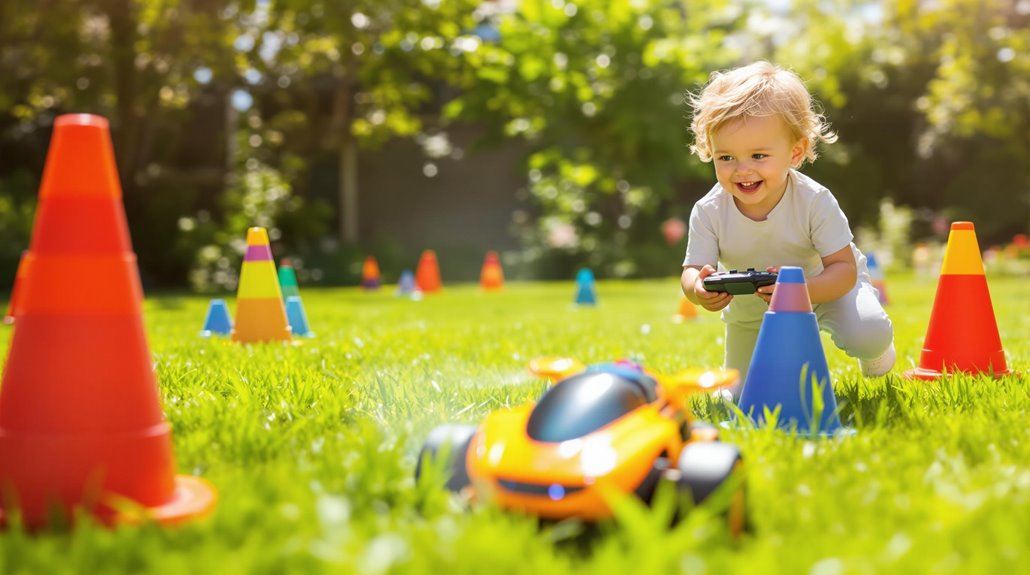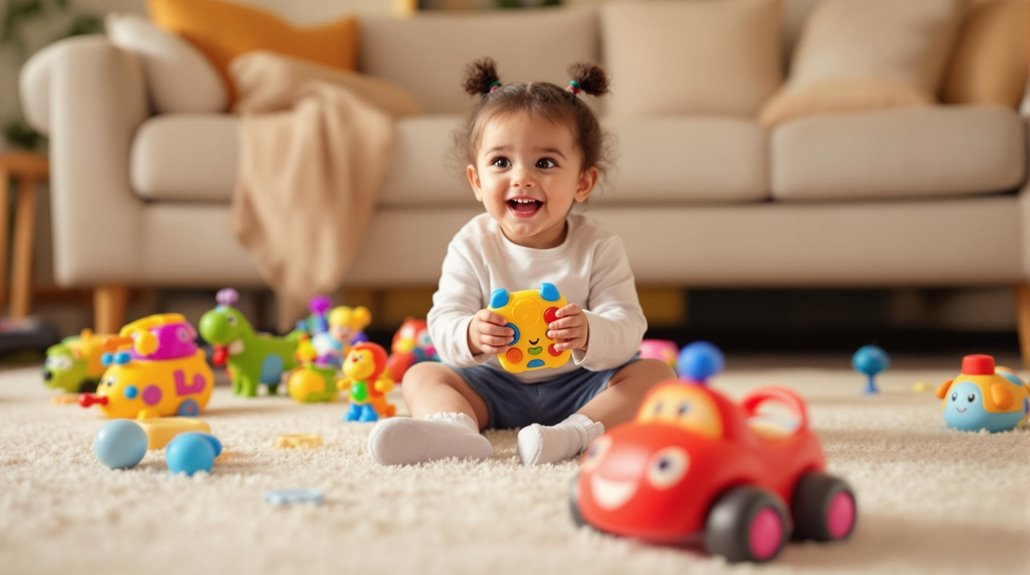The Role of Remote Control Toys in STEM Education
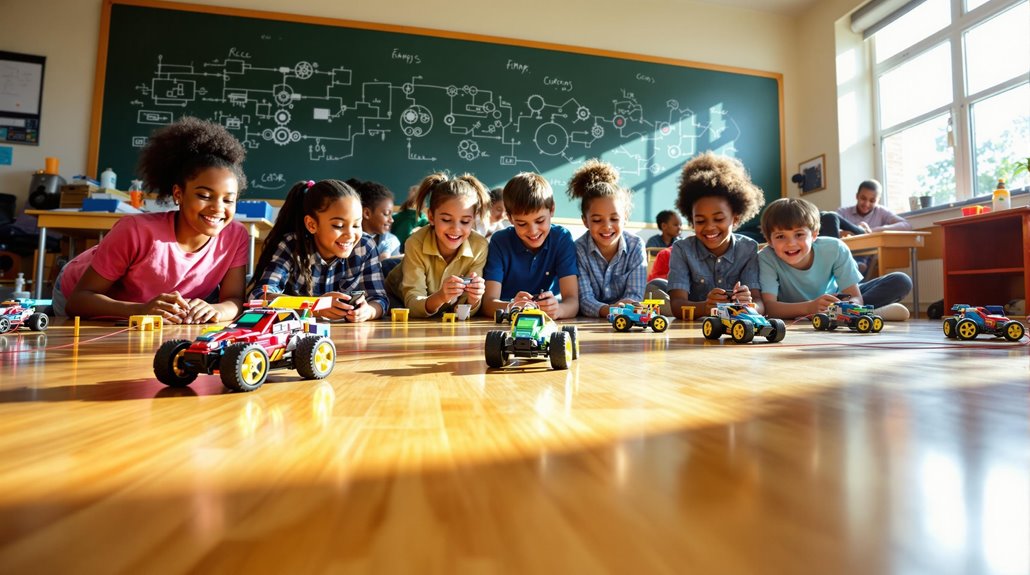
Remote control toys play a vital role in STEM education by making learning interactive and enjoyable. They help you grasp physics concepts like speed, motion, and friction through hands-on exploration. By assembling and programming these toys, you enhance your problem-solving and critical thinking skills. Collaborating with peers fosters teamwork and strengthens communication abilities. Plus, these toys introduce basic engineering and coding principles, allowing you to apply concepts in real-world scenarios. Engaging with remote control toys ignites curiosity and creativity in STEM fields, paving the way for deeper understanding. Keep going to discover even more insights on this exciting topic!
Key Takeaways
- Remote control toys facilitate hands-on exploration of physics concepts like speed, motion, and friction, enhancing STEM understanding through practical applications.
- They promote critical thinking and problem-solving skills as students assemble, operate, and modify vehicles during play.
- Coding principles are integrated by programming RC cars, making learning interactive and introducing fundamental programming concepts.
- Collaborative projects with remote control toys foster teamwork and communication among students, building essential skills for future STEM careers.
- Engaging with RC toys maintains motivation and curiosity, allowing students to see immediate results from their STEM learning efforts.
Importance of STEM Education
STEM education is crucial for preparing students for the complexities of the modern world. It goes beyond rote memorization, focusing on critical thinking skills and problem-solving skills that are essential for future job markets. By engaging with STEM concepts early on, you lay a solid foundation for understanding complex subjects later in life.
Hands-on experiences play a vital role in this learning process. When you participate in interactive activities, you not only enhance your retention of knowledge but also develop a genuine interest in technology and engineering fields. This is where engineering principles come into play, allowing you to see how theoretical concepts translate into real-world applications.
Moreover, collaborative projects within STEM education foster teamwork and communication skills. These are crucial competencies for success in both academic and professional environments. Working together on challenges teaches you how to approach problems collectively, encouraging innovative thinking and diverse solutions.
Prototyping and building is an essential aspect of STEM education, as it solidifies understanding of robotics concepts and enhances practical skills.
Benefits of Remote Control Toys
Remote control (RC) toys offer a multitude of benefits that make learning both fun and engaging. As you play with these STEM toys, you'll explore essential physics concepts like speed, motion, and friction through hands-on experiences. This interactive play enhances your understanding while fostering critical thinking and problem-solving skills. As you experiment with modifications and upgrades to improve your RC vehicle's performance, you'll develop a mindset geared toward innovation.
RC toys serve as effective tools for teaching basic engineering principles. By assembling and operating these vehicles, you'll get a firsthand look at mechanical systems and electrical circuits, laying a solid foundation for future learning. If you dive into programming RC cars, you'll unlock fundamental coding concepts, igniting an early interest in technology and computer science. Additionally, taking your child to an RC track or race course can provide a real-life experience that enhances enjoyment and solidifies their passion for the hobby.
Engaging in RC toy projects often requires teamwork. Collaborating with friends or family not only enhances communication skills but also prepares you for success in future STEM endeavors. Overall, RC toys create an exciting environment where you can cultivate valuable skills that extend beyond the playroom.
Engaging Learning Experiences
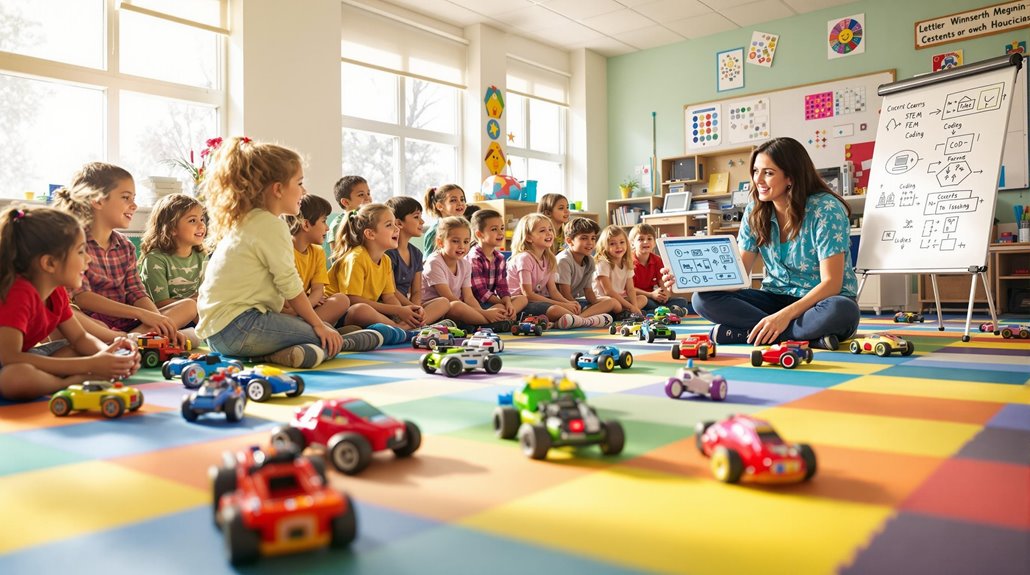
Engaging in hands-on activities with remote control toys frequently sparks curiosity and excitement among students. When you dive into the world of RC cars and drones, you're not just playing; you're experiencing a dynamic way to learn. These educational toys offer practical applications of physics concepts, fostering a deeper understanding of speed, motion, and aerodynamics. The Tinkering Labs Electric Motors Catalyst STEM Kit offers budding inventors a chance to creatively explore these concepts with hands-on tinkering and problem-solving activities. Here are four engaging learning experiences you can explore with RC toys:
- Problem Solving: As you assemble and modify RC cars, you'll tackle real challenges that enhance your critical thinking skills.
- Coding Basics: Programming your RC car introduces key coding concepts like loops and conditionals, making learning fun and interactive.
- Team Collaboration: Working on collaborative projects with peers helps you develop teamwork and communication skills, which are essential in STEM fields.
- Motivation and Engagement: The interactive nature of RC toys keeps you motivated, as you see the tangible results of your efforts in STEM learning.
These experiences not only make learning enjoyable but also equip you with vital skills for future success.
Understanding Physics Through Play
Through the lens of play, you're invited to explore the fascinating world of physics with remote control toys. Remote control cars and drones provide a hands-on experience that helps you learn the basics of physics principles like motion, speed, and friction. As you operate these toys, you'll grasp concepts such as acceleration and deceleration, witnessing the effects of forces in real-time.
Controlling the speed and direction of your RC vehicle allows you to understand vectors and how distance, time, and speed interrelate, reinforcing important mathematical concepts in a practical way. Engaging with remote control toys encourages you to experiment with different terrains, uncovering how friction influences movement and performance. This playful exploration enhances your hand-eye coordination, making the learning process enjoyable.
Moreover, by modifying and tuning your RC toys, you'll gain valuable experience in problem-solving. Testing hypotheses and observing outcomes become second nature, as you apply scientific methods to enhance your understanding of physics. In this dynamic setting, you not only learn but also develop skills that are crucial in STEM fields, setting a strong foundation for future exploration and discovery.
Additionally, understanding the power source selection of your RC car, such as deciding between nitro propulsion and electric batteries, can deepen your knowledge of energy and mechanics in action.
Engineering Principles in Action
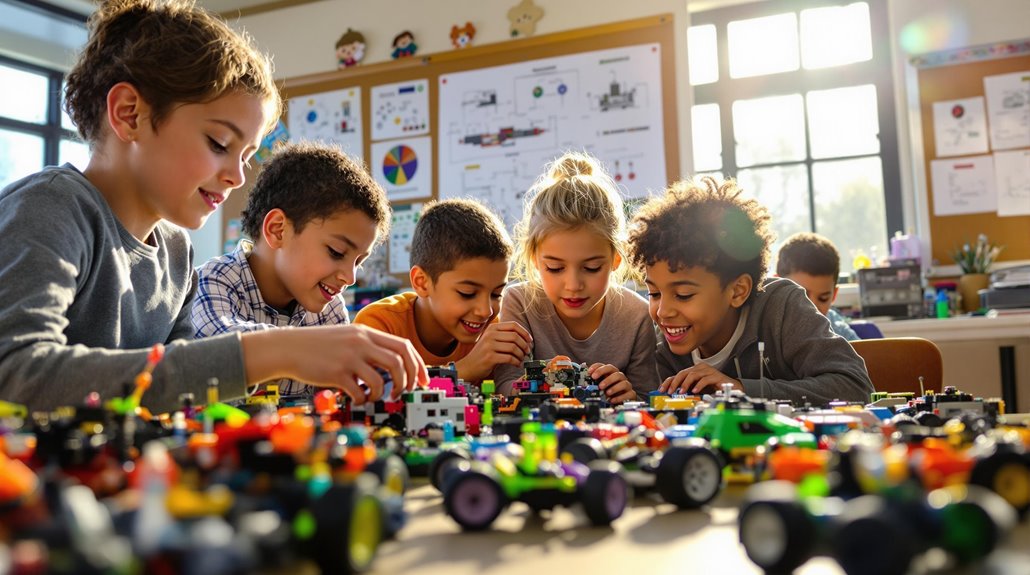
Exploration of engineering principles comes to life when you work with remote control (RC) toys, such as cars and drones. These engaging tools offer hands-on experiences that help you grasp essential concepts in mechanical engineering. You'll dive into aspects like gear assembly and motor function, enhancing your understanding of how things work. Additionally, understanding aerodynamics can significantly aid in selecting and controlling RC models, especially airplanes. Here are four key engineering principles you can learn through RC toys:
- Mechanical Engineering: Understand the basics of gear systems and motor dynamics.
- Electrical Circuits: Explore how components interact and discover the basics of electrical engineering.
- Programming Fundamentals: Learn coding concepts like loops and conditionals while programming RC cars for better performance.
- Teamwork and Collaboration: Participate in challenges and competitions that foster essential teamwork skills for future engineering projects.
Enhancing Problem-Solving Skills
Working with remote control toys not only sharpens your understanding of engineering but also significantly boosts your problem-solving skills. When you engage with RC cars, you face real-world challenges that require troubleshooting mechanical issues and optimizing performance. This hands-on experience helps you develop critical thinking as you experiment with different configurations to achieve the best results.
You'll find that applying mathematical concepts like speed calculations and distance measurements enhances your analytical thinking. As you work to improve your vehicle's performance, you're not just playing; you're actively solving problems. Programming RC cars introduces you to basic coding concepts, allowing you to create command sequences and build logical reasoning skills. Moreover, when you participate in collaborative projects involving these toys, you're practicing teamwork and communication.
These elements are essential for effective problem-solving in group settings. By working together, you learn to coordinate efforts and share ideas, which is invaluable in STEM fields. Overall, remote control toys provide a fun and engaging way to strengthen your problem-solving abilities, setting a solid foundation for future challenges in engineering and technology. For those starting out, it's beneficial to consult a buying guide for RC cars to ensure you invest in the right product that meets your needs and preferences.
Integrating Technology and Coding
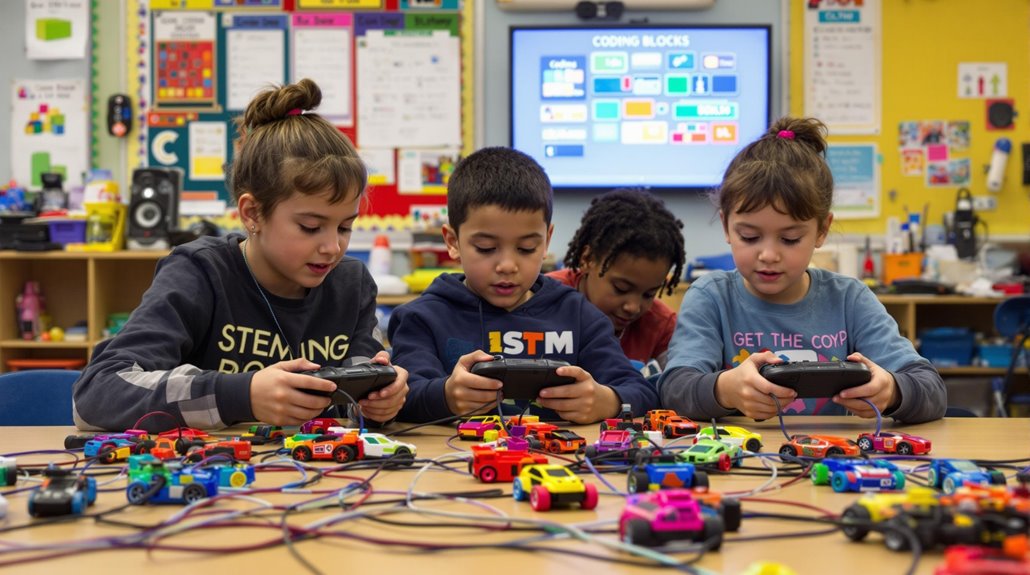
Remote control toys provide a dynamic platform for integrating technology and coding into education. By using these toys, you can engage students in hands-on learning that enhances their coding skills and understanding of engineering principles. Here are four ways RC toys facilitate this integration:
- Coding Basics: Students program movements and behaviors, learning essential coding concepts like loops and conditionals.
- Accessible Interfaces: Toys like the Ryze Tello drone use platforms like Scratch, making coding engaging and approachable for younger learners.
- Real-World Applications: Equipping RC cars with sensors allows students to write code that responds to environmental changes, applying coding principles in practical scenarios.
- Critical Thinking and Collaboration: As students troubleshoot and optimize their code, they enhance their critical thinking. Working in teams fosters collaboration, allowing them to design, program, and test their creations together.
Model kits designed for display can also be utilized in educational settings to teach about historical events and engineering design, providing a broader context for students' learning experiences.
Integrating technology and coding through remote control toys not only makes learning fun but also prepares students for future challenges in a tech-driven world. Embracing this approach ensures that students develop essential skills that are critical in today's engineering and technological landscape.
Fostering Creativity and Innovation
Integrating technology and coding through remote control toys naturally paves the way for fostering creativity and innovation in education. When kids engage with RC cars and drones, they aren't just playing; they're learning essential engineering concepts. They can design, build, and modify their vehicles, which sparks hands-on experimentation.
This hands-on approach enhances their problem-solving skills, as they face challenges that require innovative thinking to overcome. As kids create unique scenarios for their toys, their imagination expands, allowing them to explore various solutions. Adding programming elements, like coding RC cars to follow specific paths, encourages them to think critically about achieving specific outcomes.
Collaborative projects also play a crucial role—when kids work together, they share ideas and brainstorm creative modifications, boosting teamwork and communication skills. Engaging in outdoor recreation through activities like flying RC planes fosters appreciation for nature and outdoor settings. The tangible results of their efforts, such as successfully navigating a course or racing against friends, not only motivate them but also inspire further exploration in STEM fields.
Ultimately, remote control toys cultivate a rich environment for creativity, helping kids develop valuable skills that will serve them well in the future.
Future Trends in STEM Toys
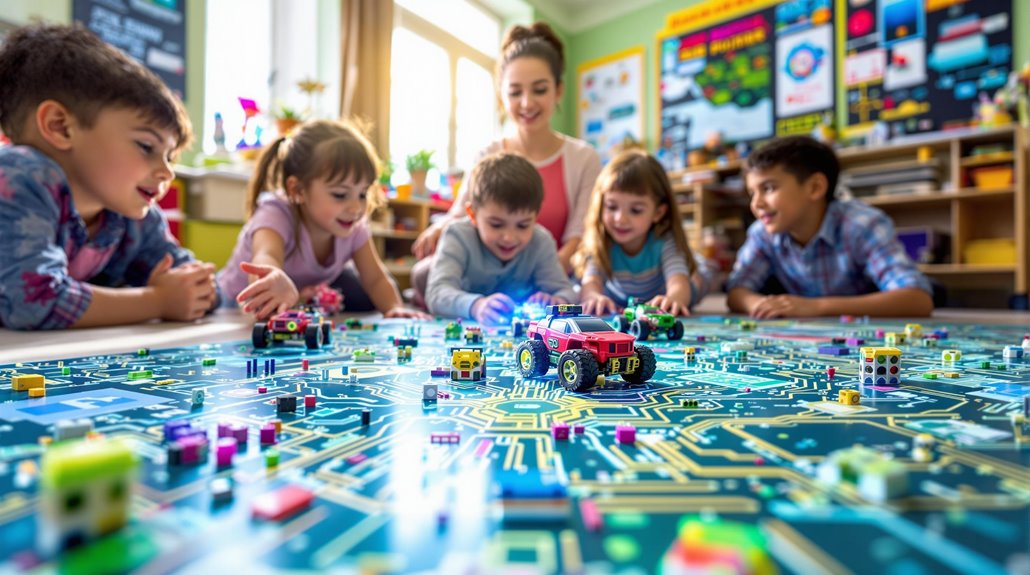
The landscape of STEM toys is rapidly evolving, with exciting trends that promise to transform how children learn and engage with technology. As you explore these trends, you'll notice an increased focus on enhancing critical thinking and engineering skills through innovative design and technology.
Here are four key trends to watch:
- Advanced Technologies: Integration of AI and robotics in STEM toys enhances interactive learning, making coding and engineering principles accessible and engaging.
- Real-World Applications: Future STEM toys will connect complex subjects like physics and programming to hands-on play, helping kids see the relevance in their everyday lives.
- Customizable Designs: Expect a shift toward modular designs that encourage experimentation. Children will have the freedom to modify their toys, fostering creativity and innovation.
- Community Collaboration: Manufacturers are increasingly prioritizing collaboration, offering resources for educators and families to share insights, experiences, and best practices.
Engaging in activities like building robot model kits helps develop fine motor skills and hand-eye coordination, which are essential for thriving in a tech-driven world.
As these trends take shape, you'll find that STEM toys are not just about play; they're powerful tools for developing problem-solving skills and fostering a love for learning.

